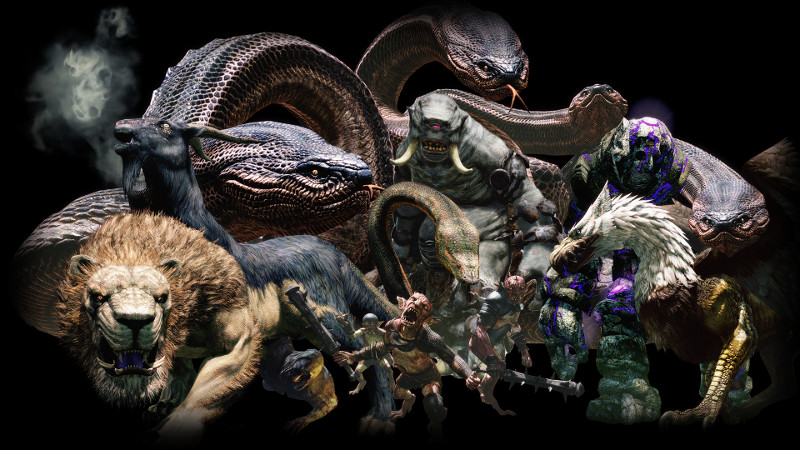Dragon's Dogma Bestiary: Harpies

This is the fifth post of a series converting Dragon’s Dogma enemies to GURPS. Previous posts can be found below:
From a distance, harpies look like man-sized owls, with round heads and thick plumage. Only when they take flight and turn on you is it possible to notice their human-like faces and upper torsos. These features are invariably those of women: though there are male harpies, it’s impossible to tell the difference without dissection.
Harpies also have feminine voices, though they seem to be incapable of verbal communication. In fact, they behave like large birds of prey, nesting at high altitudes and ranging far and wide in search of prey. Harpies are full carnivores and will attack anything that seems meaty enough to sustain them - even people. They are an ever-present hazard in Gransys’ highlands and mountain passes.
Note that these harpies are different from the those presented in GURPS Dungeon Fantasy Monsters 3: Born of Myth and Magic. You are free to use those here as well!
No one has managed to tame a harpy, but those crazy enough to try are willing to pay handsomely for unhatched eggs. Fetching those would require climbing the steep crags where they make their nests, a challenging proposition even if one doesn’t have to contend with a choir of enraged harpies on the way up.
These creatures originally came from beyond the world: ancient accounts of past draconic invasions report armies of them arriving through the same rift as the Dragon itself. Several stable populations remain:
Brown Harpies
These inhabit the mountain chain separating South and Central Gransys, as well as the mountains to the soutwest beyond the Shadow Fort. Their skin is an ashen grey, covered in dark brown feathers.
Brown harpies have innate magical abilities: their song can compel other creatures to sleep, an effect that becomes stronger the more voices are added to the choir. Brown harpies live in bands (“choirs”) of 4-6 adults.
Brown harpies fight by using their soporific song and then grappling their sleeping victims and dropping them from a great height. If they can’t do that (because the target is too heavy, or resists the song), then they’ll attempt to rake with their talons. As detailed in Dungeon Fantasy Monsters 3, harpy flyby attacks receive the -4 for Move and Attack but don’t have their skill capped at 9, and they may retreat up while dodging to receive a +4 bonus.
ST 15; DX 13; IQ 6; HT 13
SM +1; Dodge 9; DR 2;
HP 15; Will 10; Per 12; FP 13
Basic Speed 6.50; Move 3 (Ground)/13 (Air)
- Soporific Song (15 vs Will): Resisted by Will, at -1 per singing harpy beyond the first. Affects non-harpies within 10m who hear the song. First failure causes sluggishness (1/2 Move and Dodge) while the song lasts. Second failure causes the target to fall asleep for 1 hour or until awoken, possibly by being dropped from a great height by the harpy.
- Talons (16): 1d+3 cut. Reach C. May also grapple at skill 14.
- Bite (16): 1d+2 cut.
Traits: Acute Vision 2; Claws (Talons); DR 3 (Tough Skin); Flight (Winged); Peripheral Vision; Striking ST 4; Teeth (Sharp); Bestial; Fragile; Social Stigma (Monster).
Skills: Aerobatics-14; Brawling-16; Wrestling-14
Class: Faerie.
Snow Harpies
These inhabit the northern highlands of Gransys, particularly the area known as Souflayer Canyon. Their skin is black, and their feathers are snow-white with black spots. Snow harpies possess the same soporific song as their southern cousins, and are also endowed with a deadly frost breath attack. Use the same stats for a brown harpy, but add Temperature Tolerance 2 for cold and the following attack:
- Frost Breath (14): Jet (range 5/10). 1d cr damage with no knockback and no blunt trauma. Targets hit by this must roll HT with a penalty of -1 per 2 points of damage suffered or be frozen (paralyzed) for 1 minute per margin of failure. Each snow harpy can use this only once per fight.
Succubi
While they share some similarities with harpies, succubi are demons rather than mere magical creatures. Immortal spirits given physical form, they linger in sites of ancient draconic invasions, or close to the Dragon itself during them. Visually, the main difference between an harpy and a succubus is that a succubus’ lower body and wings are those of a bat, not a bird. Their fur and wing membranes are dark brown in color.
They have all the same abilities as common harpies, but their bite also carries a deadly venom, and their touch carries a curse. Take the stats for a brown harpy and add Immunity to Metabolic Hazards as well as an 1d toxic follow-up to their bite. Add the following attack:
- Demonic Curse (15 vs. Will): Targets an enemy the succubus can see, suffers from range penalties. Targets who lose the contest suffer from a 1-point Curse as per the spell on GURPS Magic, p. 129. Doesn’t work on an already cursed target.
Silver Sirens
These creatures resemble silver-colored succubi, and are actually guardian spirits summoned by forgotten sorcery. Therefore, they can usually be found in dungeons protecting something important. Unlike all other monsters presented in this article, they are not only sapient but also know magic! While Silver Sirens can fight in much the same way as harpies, they prefer to cooperate with stronger guardian beasts, which they target with healing and support spells while staying out of melee reach.
To make a Silver Siren, take the stats for a Brown Harpy and add Immunity to Metabolic Hazards. Remove Bestial, change IQ to 12+, and add Magery 2+ along with Healing and Body Control spells meant to buff allies. This magic requires song, in the same manner as that of a bard.